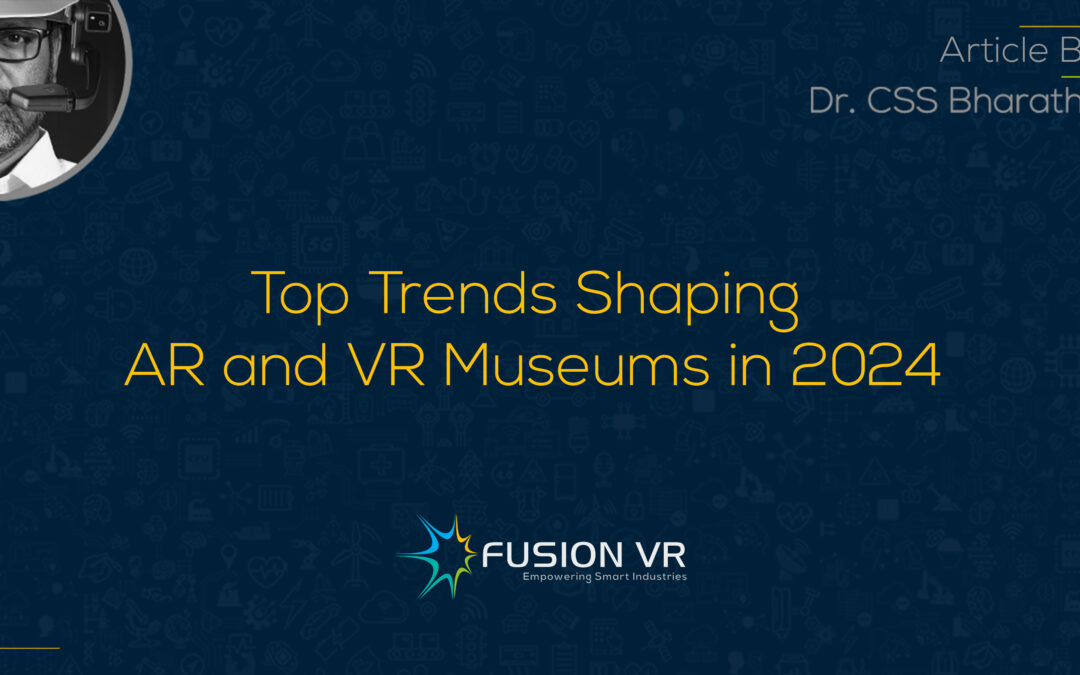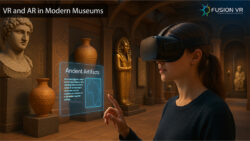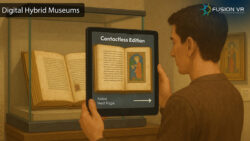This year, 2024 would be an eventful year for many people across the globe as it aims to bring elections and major events in many important countries around the world. These events and the milestones it establishes could be pivotal and remain in the hearts and minds of many. Every industry and sector is doing something remarkable that will be remembered. The world of museums will not be alone when all of this is happening. The rapid growth of technology and the pace of adoption promises new developments in museums and many more millions of visitors. Making everything interactive and immersive seem to be buzzwords wherever you go. Everything from the most important to the mundane is influenced by a wave of interactivity and immersiveness around them. These developments as you would expect are going to shape the trends we would see in museums in this year and beyond.
Augmented Reality (AR) and Virtual Reality (VR) along with a host of other cool technologies would be the enabling forces shaping the new trends in museums in 2024. Both technologies are gaining immense popularity among museum professionals for their capabilities in putting together immersive experiences. Augmented reality enables the overlay of digital content, information and interactions on the most commonly availables device today, smartphones. The development and availability of apps is more widespread than ever. The trend that we expect is that more people move away from traditional habits and embrace the use of AR devices such as smartphones and tablets to receive an interactive visitor experience.
Museums are also expected to develop and make available free of cost, the applications that guide visitors with essential information and also deliver a museum experience that is so personalized, interactive and immersive. The ability to deliver an interactive storytelling experience with AR is wonderful. AR Digital guides will replace or supplement the traditional human guides at museums. It will also deliver a content rich experience that is based on your preferences and available time to spend in a museum. The AR museum app on the smartphone opens up a treasure trove of information about a painting or an artifact that you encounter in the museum. AI powered applications will ensure that the visitor is engaged interactively through visuals, animation and voice. AI also would understand your preferences and guide you to view those exhibits that match your preferences. The AR experience would also alert you to participate in events such as talks, shows, lectures etc. that are typically organized in museums. As you proceed to the show, the interactive application would fill you in with details on the event. One key trend that is also expected to see is a greater integration of social media with such interactive museum experiences that will enable the visitor to share their experiences with their families and friends. This kind of sharing is more authentic and leads to more visitors wishing to visit the museum and experience its offerings.
Virtual Reality is completely immersive and offers greater excitement of the two technologies we have. The use of virtual reality will continue to dominate the trends that we would observe in 2024. There will be an increased trend to commission VR experience centers that enable a kind of time travel into the past or future. Most of us tend to use our imagination to create spaces and characters about historical events that we have read or heard before. Virtual reality enables us to get a near authentic experience of historical events. It is also the door to visualize the future of human civilization based on expert information. Anyone who has used a VR headset can attest to the magic that VR unveils in front of your eyes. Virtual reality experiences and exhibits are unique and the experience of being immersed in a new environment , although recreated, leaves a real-life impression and makes it memorable. Museum owners and administrators are interested in such experiences that bring more visitors to their institutions.
Another trend that is most likely to emerge is the increasing use of museum resources to provide learning opportunities for academic needs. Most museums offer the opportunity for kids to learn outside the confines of their conventional classrooms. The education delivered through classrooms is currently reinforced through tests, quizzes and exams. The engagement of students along with their understanding and retention of concepts is fairly low in the current approach. Institutions have understood that experiential learning outside the school walls is more beneficial. A field visit to the museum reinforces what is taught in the classroom and creates the opportunity to learn more in a museum. A museum visit is a kind of show and tell on a much larger scale. This would eventually lead to the establishment of various kinds of museums like science and technology museums. This will also be a positive trend that engages the academic community in the growth, development and popularity of museums worldwide. The educational partnership between museums and schools will continue to generate a steady stream of young visitors that will maintain a vibrant atmosphere and offer the impetus for future partnership opportunities in the museum space.
The infusion of technologies in museums will also promote the growth of virtual museums. With the growth in computing and communication technologies, the devices we carry in our hands all the time, becomes a powerful medium to experience museums virtually. The smartphone allows you to experience the wonders of a museum without ever stepping into it. This is a trend that we continue to see growing, particularly after the COVID-19 pandemic. There are millions of people who may not have the time and the resources to travel to the great museums of the world to enjoy its delights. Fortunately, technological growth has become a great leveler and has made it possible for anyone to obtain a real life experience in those museums. Virtual museums offer the ability to enter into a virtual replica of the actual museum and mimic the experience of walking through it, getting up close to an exhibit and experiencing its wonderful exhibits. In fact this experience could be much more detailed than a real life visit. The world’s most famous painting, the Mona Lisa sits in a glass cage to protect it from deterioration induced by human factors. Many of the world’s greatest museums like the Louvre have commissioned wonderful virtual reality experiences that have delivered a wonderful immersive experience for a global audience. The Louvre has Mona Lisa: Behind the Glass exhibit that speaks so much about the painting and bringing alive Mona Lisa, albeit virtually to fully appreciate the magic of Leonardo da VInci’s artistic brilliance. There are more such stunning exhibits and the trend to present such exhibits virtually will continue in 2024 and the years beyond.
As a leader in the museum industry in India, Fusion VR has created several exhibits for prominent museums across the country. Our clientele includes several governmental, non-governmental and private institutions who appreciate the skills and expertise that we offer in interactive and immersive AR VR museum experiences. We also serve corporate clients with our Corporate Experience center offerings. These Museum 2.0 capabilities are the result of more than two decades of pioneering work in creating and delivering interactive experiences for AR VR Museums. Visitors to the Amma Museum and Knowledge park in Chennai and the RKM Museums across the country provide a glimpse into the conceptual, artistic and technical capabilities of our team. We encourage you to visit our Museum 2.0 webpage to learn more about our capabilities and ride the top trends in the museum space that has been highlighted above.





